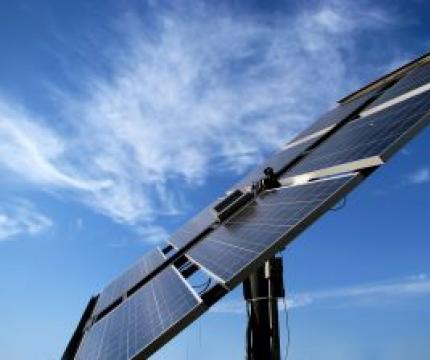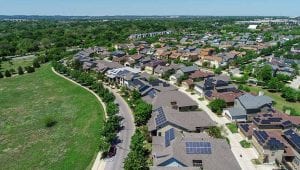According to EIA’s new survey-based estimate of total solar capacity, total on-grid photovoltaic (PV) capacity nearly doubled in 2011, led by particularly strong growth in both utility-scale PV and commercial sector PV capacity. Although 2011 was a record year for solar PV growth, solar PV capacity has consistently grown over the past few years. The Interstate Renewable Energy Council (IREC) reports that total grid-connected PV capacity quadrupled between 2008 and 2011.
The recent growth in utility-scale PV projects is especially noteworthy. This category was all but nonexistent only five years ago, when the residential and commercial sectors accounted for nearly all of the PV installations. While a residential PV system might comprise only a few solar panels and 5 to 20 kilowatts of capacity, utility-scale plants have capacities of 1 megawatt (MW) and above. Utility-scale PV capacity grew from just 70 MW in 2008 to 1,052 MW in 2011. In fact, prior to 2011, the majority of utility-scale solar capacity was concentrating solar technology, and not PV.
Both the number and average size of utility-scale projects are increasing. According to data reported to EIA as of August 2012, the 10 largest operational PV plants all exceed 20 MW; there were no PV projects of this scale operating prior to 2009. Although total utility-scale PV capacity still accounts for only about 0.1% of total generating capacity of all types in the United States, PV accounted for 3% of new capacity additions in 2011, and 5% of 2012 capacity additions (through August, the most recent month for which data are reported to EIA). Because the utilization rate for PV, which is governed by the availability of sunlight, is lower than for other types of capacity, PV’s generation share is well below its capacity share.
Smaller-scale residential and commercial projects (sometimes referred to as distributed capacity) still account for the majority of on-grid PV installed capacity. In 2012, both utility and nonutility scale installations are on track to exceed the level of capacity additions realized in 2011. EIA data on utility-scale PV capacity show 589 MW installed through August 2012 and an additional 944 MW under construction and scheduled to be complete by year end. This growth is matched by growth in the commercial and residential sectors, according to the Solar Energy Industries Association’s (SEIA) reports for the first and second quarter of 2012.
Multiple federal, state, and local programs encourage solar power development. At the federal level, solar projects built through 2016 are eligible for a 30% investment tax credit (ITC). In addition, ITC-eligible projects that were under construction by the end of 2011 were eligible to claim the 30% credit as an upfront cash grant from the U.S. Treasury Department’s 1603 program.
Thirty states also currently have mandatory renewable portfolio standards (RPS). More than half of those policies include provisions that offer added incentives for solar and distributed generation facilities, either through mechanisms such as awarding bonus credits for solar generation, or by requiring that a certain portion of the RPS be fulfilled by solar or distributed generation. Many states also offer net metering for distributed solar PV capacity, which compensates distributed generation owners for power produced in excess of on-site usage. The states with the most total solar PV capacity in 2011 were California, New Jersey, Arizona, Colorado, and New Mexico, all of which have policies designed to encourage solar power.
PV costs have also been declining. According to SEIA’s first and second quarter Solar Market Insight reports, module costs alone have fallen to less than half of the level seen only two years ago. The costs for a full, installed system are also generally on the decline, due to falling component costs and increased experience in installation. This is particularly true for smaller-scale customer-sited projects, although these projects are still generally more expensive on a dollar-per-watt basis. However, despite recent cost declines, grid-connected solar PV installations still generally rely on incentives in order to be competitive with retail and wholesale electricity.
Originally posted on Cleantechnica. Re-published with permission.










